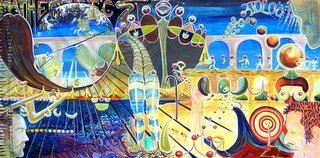 The Fruit Face Guardian
The Fruit Face Guardian, 1997, Oil on cavas
Painter: Ham
From: Poly-Morph series.
This is the first painting in which it is easy to see how things such as fruit are used to make other things. In this case, food is used to make a face. Many artists use this idea. Eggs are used for eyes and bananas are eyelids etc.
The Fruit Face Guardian is from my
Polymorph series of paintings, being the series in which I created my
polymorph characters. These characters were then further developed over the next ten years populating the
Hybrid Cryptic. The basic idea of using objects or things such as fruit to make other things, increases ones appreciation of shapes; how can I use these shapes to represent shapes that define a face; will this fit with that; how can these pieces fit together? etc.Working with questions, such as those just stated, in mind, softens ones perspective towards looking into things in order to realise how they may be used together. In short, such practical application of shpaes in art exercise a deeper (subcinsious familiarity) understanding of things.
The idea of looking into ones self in order to learn more about the world one lives within, is a concept art shares with science. An important step in learning. The idea of reflecting upon; reviewing; thinking through the knowledge one has obsorbed is like working out a puzzle. , by taking abstract shapes and organising them into recognisable forms; taking many small things and arrnging them into on e big thing; using objects such as fruit and using them to make a face, etc What is the point? Learning how to connect things (shapes) together is an abstract art form called thinking. It is very healthy!
Exercise the mind.
Recognising and knowing how things fit together is confiedence.
Being able to creatively think through problems by bringing the parts together to form a solution is intelligence.
Likewise reflecting on what one is seeing by recognising smaller things within bigger things and their relationship to the whole is the exercise used to create
The Fruit Face Guardian. It is an esay puzzle to figure out because it is obvious. You can easily see bits of food forming a face. Take a look.
Whether one reflects upon what one is looking at or not, all my paintings are created with my love of finding things within things. So if you look into them you will find a story being told about a journey within that is detailed the joining together of things.
A magical maze of characters and their creation unfolds.




